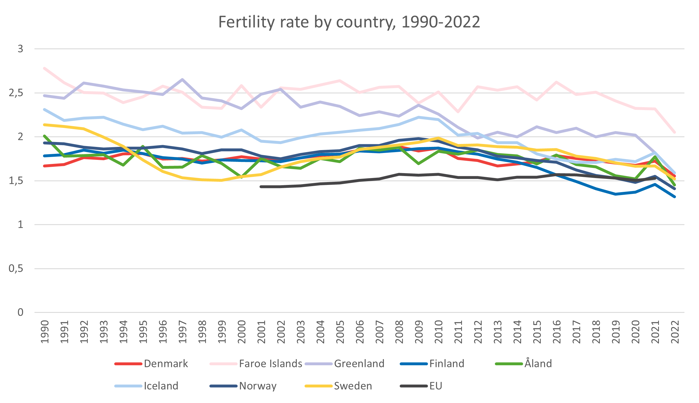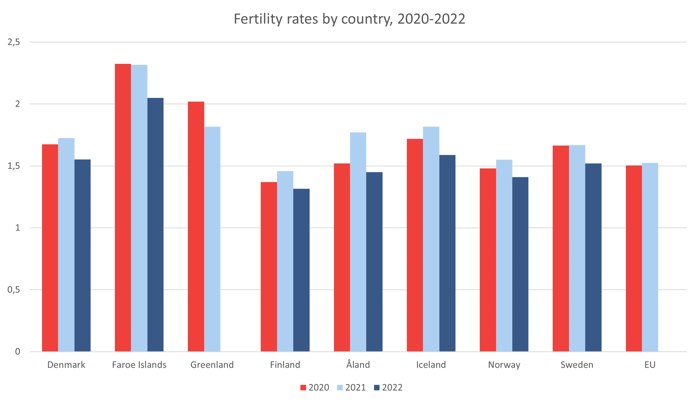All-time low Nordic fertility rates
The Nordic fertility rates have steady declined for decades, as has the worlds. During the pandemic, from 2020 to 2021, the number of births increased in all Nordic countries except for Greenland, but the whole region reported sharp declines in fertility rates in 2022. Finland had the lowest fertility rate of all Nordic countries, 1.32 children. This is also the lowest Finnish rate since 1776 when monitoring of fertility rates first started [1].
The world fertility rate (expressed as the number of children per woman) has steadily decreased during the last decades. In 2021, the world’s fertility rate stood at 2.3. This is slightly above the replacement rate of 2.1 children per woman, which allows for one generation to replace itself, and down more than two times from 4.8 in 1970. According to the UN, nearly two-thirds of the world’s population today lives in a region where the fertility rate is below the 2.1 threshold.
The measure of total fertility shows how many (live) children a woman would give birth to if she gave birth during her lifetime as women do today. It is comparable across countries since it considers changes in the size and structure of the population.
Although there are obvious issues with the large global population, a different set of issues arise when fertility rates fall below replacement levels. Dropping fertility rates can lead to shrinking populations and a higher ratio of elderly to working adults.
Nordic fertility over time
The pattern of shrinking fertility rates is the same in the Nordic countries. Fertility rates have fallen throughout the entire region over the last decades, and in just ten years it has dropped by between 7 (Denmark) and 25 percent (Finland) in the respective countries. In the EU it declined by 1 percent during the same period.
During the pandemic, the Nordic Region experienced an increase in the number of births. In all Nordic countries except Greenland, the fertility rate was higher (and thus more children were born) in 2021 than in 2020, although the increase in Sweden was marginal. But then, in 2022, a sharp dip in fertility rates was seen – the Nordic average decline in just one year was 11 percent.

Source: Nordic Statistics Database, CHIL02: Fertility rates by age, time and reporting country
Fertility in 2022
The lowest rate in 2022 was reported from Finland, 1.32 children. This is also the lowest Finnish birth rate since monitoring started in the year 1776 [1]. Then came Norway with 1.41 children, Åland with 1.45, Sweden with 1.52, Denmark with 1.55, Iceland with 1.59 and Faroe Island with 2.05 children. For Greenland the 2022 value is not yet available, but between 2020 and 2021 the fertility rate there dropped by 9 percent, to 1.82.

Source: Nordic Statistics Database, CHIL02: Fertility rates by age, time and reporting country
Statistics Sweden reports that birth rate continues to decline in 2023. When the first half of the year was analysed, the number of children born per woman was the lowest in over 50 years. [2]
Why?
Why the fertility rates are going down is not clear at the moment. The same pattern of decline can be seen across all age groups (see database, CHIL02).
“The Nordic countries are in general level good welfare states”, says Nora Sanchez Gassen, political scientist, demographer at Nordregio. “They have good social support; they are stable countries with high levels of social trust. In general, these should be considered good conditions to raise children, but nonetheless we see that fertility is declining.”
Sanchez Gassen suggests that one reason for why fertility has declined in the Nordic countries during the last decade is that there is an increasing number of couples who voluntarily or involuntarily remain childless. Those who decide against having a child may do so for different reasons, may it be financial, related to climate change or others. [3]
_________________________________________________________________________________
[1] https://www.stat.fi/en/publication/cl8mya8io1v2u0dutwqqanzqx
[2] https://www.scb.se/pressmeddelande/barnafodandet-sjunker--lagsta-pa-over-50-ar/
[3] https://unric.org/en/family-day-nordic-fertility-rates-in-steady-decline/